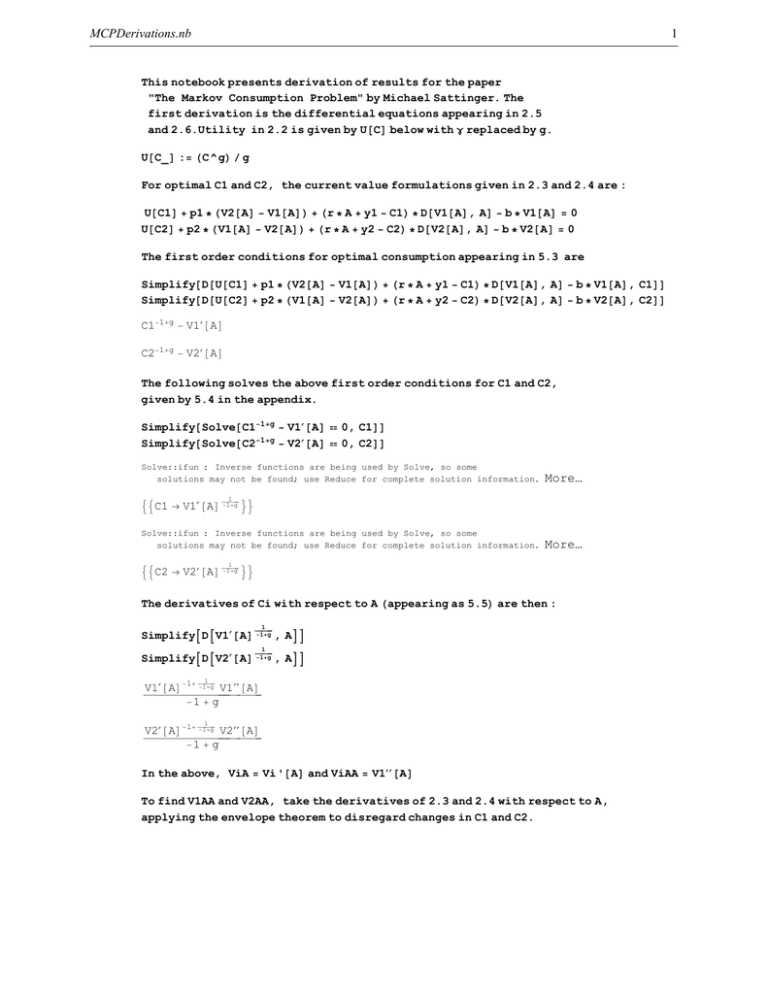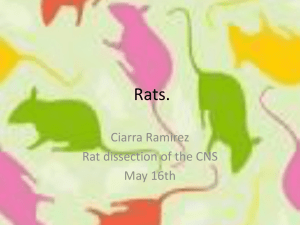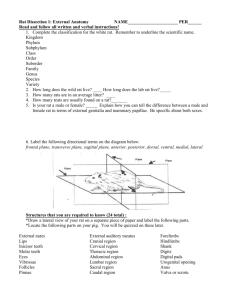Derivations
advertisement

MCPDerivations.nb
1
This notebook presents derivation of results for the paper
"The Markov Consumption Problem" by Michael Sattinger. The
first derivation is the differential equations appearing in 2.5
and 2.6.Utility in 2.2 is given by U@CD below with γ replaced by g.
U@C_D := HC ^ gL ê g
For optimal C1 and C2, the current value formulations given in 2.3 and 2.4 are :
U@C1D + p1 ∗ HV2@AD − V1@ADL + Hr ∗ A + y1 − C1L ∗ D@V1@AD, AD − b ∗ V1@AD = 0
U@C2D + p2 ∗ HV1@AD − V2@ADL + Hr ∗ A + y2 − C2L ∗ D@V2@AD, AD − b ∗ V2@AD = 0
The first order conditions for optimal consumption appearing in 5.3 are
Simplify@D@U@C1D + p1 ∗ HV2@AD − V1@ADL + Hr ∗ A + y1 − C1L ∗ D@V1@AD, AD − b ∗ V1@AD, C1DD
Simplify@D@U@C2D + p2 ∗ HV1@AD − V2@ADL + Hr ∗ A + y2 − C2L ∗ D@V2@AD, AD − b ∗ V2@AD, C2DD
C1−1+g − V1′ @AD
C2−1+g − V2′ @AD
The following solves the above first order conditions for C1 and C2,
given by 5.4 in the appendix.
Simplify@Solve@C1−1+g − V1′ @AD 0, C1DD
Simplify@Solve@C2−1+g − V2′ @AD 0, C2DD
Solve::ifun : Inverse functions are being used by Solve, so some
solutions may not be found; use Reduce for complete solution information.
99C1 → V1′ @AD
1
−1+g
More…
==
Solve::ifun : Inverse functions are being used by Solve, so some
solutions may not be found; use Reduce for complete solution information.
More…
1
−1+g ==
99C2 → V2′ @AD The derivatives of Ci with respect to A Happearing as 5.5L are then :
SimplifyADAV1′ @AD −1+g , AEE
1
SimplifyADAV2′ @AD −1+g , AEE
1
1
−1+g V1′′ @AD
V1′ @AD−1+ −1 + g
1
−1+g V2′′ @AD
V2′ @AD−1+ −1 + g
In the above, ViA = Vi '@AD and ViAA = V1′′ @AD
To find V1AA and V2AA, take the derivatives of 2.3 and 2.4 with respect to A,
applying the envelope theorem to disregard changes in C1 and C2.
MCPDerivations.nb
2
Simplify@D@U@C1D + p1 ∗ HV2@AD − V1@ADL + Hr ∗ A + y1 − C1L ∗ D@V1@AD, AD − b ∗ V1@AD, ADD
Simplify@D@U@C2D + p2 ∗ HV1@AD − V2@ADL + Hr ∗ A + y2 − C2L ∗ D@V2@AD, AD − b ∗ V2@AD, ADD
−Hb + p1 − rL V1′ @AD + p1 V2′ @AD + H−C1 + A r + y1L V1′′ @AD
p2 V1′ @AD − Hb + p2 − rL V2′ @AD + H−C2 + A r + y2L V2′′ @AD
Simplify@Solve@−Hb + p1 − rL V1′ @AD + p1 V2′ @AD + H−C1 + A r + y1L V1′′ @AD 0, V1′′ @ADDD
Simplify@Solve@p2 V1′ @AD − Hb + p2 − rL V2′ @AD + H−C2 + A r + y2L V2′′ @AD 0, V2′′ @ADDD
Hb + p1 − rL V1′ @AD − p1 V2′ @AD
99V1′′ @AD → ==
−C1 + A r + y1
−p2 V1′ @AD + Hb + p2 − rL V2′ @AD
99V2′′ @AD → ==
−C2 + A r + y2
The above are the solutions for ViAA appearing in 5.8 and
5.9. Substituting into the derivatives of Ci with respect to A above yields :
Hb+p1−rL V1 @AD−p1 V2 @AD
V1′ @AD −1+g −C1+A r+y1
SimplifyA E
−1 + g
1
′
−1+ ′
−p2 V1 @AD+Hb+p2−rL V2 @AD
V2′ @AD −1+g −C2+A r+y2
SimplifyA E
−1 + g
1
−1+ ′
′
1
−1+g HHb + p1 − rL V1′ @AD − p1 V2′ @ADL
V1′ @AD−1+ H−1 + gL H−C1 + A r + y1L
1
−1+g H−p2 V1′ @AD + Hb + p2 − rL V2′ @ADL
V2′ @AD−1+ H−1 + gL H−C2 + A r + y2L
C1−1+g
To express these differential equations in terms of consumption levels,
use the first order conditions for consumption given above by C1−1+g − V1′ @AD =
0 and C2−1+g − V2′ @AD = 0. Substituting Ci−1+g for Vi '@AD into the differential
equations for C1 and C2 yields expressions in terms of C1, C2 and A.
1
−1+g
C1−1+g
HHb + p1 − rL C1−1+g − p1 C2−1+g L
SimplifyA E
H−1 + gL H−C1 + A r + y1L
−1+ 1
−1+ −1+g
C2−1+g
H−p2 C1−1+g + Hb + p2 − rL C2−1+g L
SimplifyA E
H−1 + gL H−C2 + A r + y2L
−1+ 1
HC1−1+g L −1+g H−C2−1+g p1 + C1−1+g Hb + p1 − rLL
H−1 + gL H−C1 + A r + y1L
−1+ 1
HC2−1+g L −1+g H−C1−1+g p2 + C2−1+g Hb + p2 − rLL
H−1 + gL H−C2 + A r + y2L
These simplify to the differential equations in Result 1, equations 2.5 and 2.6.
Appendix A .2. Equation 2.8 in Result 2. Assume singularity at As with C1 > 0,
b > r.Then the numerator must be zero :
MCPDerivations.nb
3
C2 y
i
i
i j
z
j
SimplifyASolveAj
j
z
jr − b − p1 ∗ j
j1 − j
C1 {
k
k
k
−1+g
yz
y
z
z
zz
z 0, C2EE
{{
Solve::ifun : Inverse functions are being used by Solve, so some
solutions may not be found; use Reduce for complete solution information.
More…
1
−1+g
b + p1 − r 99C2 → C1 J N
==
p1
Appendix A .3. Derivation of Equation 2.10 in Result 3 Hslope of C2 at AminL. Applying
l ' Hospital' s Rule, the derivative of the numerator of dC2 ê dA is
Simplify@D@HC2@AD ê H1 − gLL ∗ Hr − b − p2 ∗ H1 − HHC2@AD ê C1@ADL ^ H1 − gLLLL, ADD
1
C2@AD −g
JJ N J−H−1 + gL p2 C2@AD2 C1′ @AD +
2
C1@AD
H−1 + gL C1@AD
C2@AD g
H−2 + gL p2 C1@AD C2@AD C2′ @AD + Hb + p2 − rL C1@AD2 J N C2′ @ADNN
C1@AD
At C2@AminD = 0, this reduces to :
HHb + p2 − rL C2′ @ADL
H−1 + gL
The derivative of the denominator is
Simplify@D@r ∗ A + y2 − C2@AD, ADD
r − C2′ @AD
Then
1
HHb + p2 − rL C2′ @ADL
C2′ @AD = r − C2′ @AD
H−1 + gL
Dividing both sides by C2′ @AD yields an equation that can be solved for C2′ @AD :
Hb + p2 − rL
r − C2′ @AD = H−1 + gL
Hb + p2 − rL
SimplifyASolveAr − C2′ @AD == , C2′ @ADEE
H−1 + gL
b + p2 − g r
99C2′ @AD → ==
1−g
This is the expression for 2.10 in Result 3.
Appendix A .4., derivation of dC1 ê dA at singularity As in Section 3
on numerical method. Applying l ' Hospital' s rule at the singularity,
the derivative of the numerator of dC1 ê dA is :
MCPDerivations.nb
4
i
i
i C1@AD y
j
j
SimplifyADAHC1@AD ê H1 − gLL ∗ j
j z
z
jr − b − p1 ∗ j
j1 − j
k C2@AD {
k
k
1−g
yz
y
z
z
zz
z, AEE
{{
1
H−1 + gL C2@AD2
C1@AD −g
C1@AD g
JJ N JH−2 + gL p1 C1@AD C2@AD C1′ @AD + Hb + p1 − rL J N C2@AD2 C1′ @AD −
C2@AD
C2@AD
H−1 + gL p1 C1@AD2 C2′ @ADNN
−1+g
i
i
yz
y
i C2@AD y
j
z
j
z
Since j
j z
z
jr − b − p1 ∗ j
j1 − j
zz
z=
C1@AD
k
{
k
k
{{
0 from the proof of Result 2. i. in Appendix Section A .2,
the derivative above reduces to
1−g
i
i
yz
y
i C1@AD y
j
j
z
SimplifyAHC1@AD ê H1 − gLL ∗ DAj
j z
z z
jr − b − p1 ∗ j
j1 − j
zz
z, AEE
C2@AD
k
{
k
k
{{
−g
C1@AD
p1 C1@AD I M H−C2@AD C1′ @AD + C1@AD C2′ @ADL
C2@AD
− C2@AD2
The derivative of the denominator of dC1 ê dA is :
Simplify@D@r ∗ A + y1 − C1@AD, ADD
r − C1′ @AD
Then applying l ' Hospital' s rule at As yields
C1@AD
i
p1 C1@AD I M H−C2@AD C1′ @AD + C1@AD C2′ @ADL y
j
z
C2@AD
j
z
′
j
z
C1 @AD = j
z
j
z
j− z ì Hr − C1 @ADL
2
j
z
C2@AD
k
{
−g
′
This simplifies to
C1@AD 1−g
C1@AD
i
p1 I M
I− C1′ @AD + C2′ @ADM y
j
z
j
z
C2@AD
C2@AD
j
z
j
−
z
C1 @AD = j
z
j
z
′
j
z
Hr − C1 @ADL
j
z
k
{
′
HThe author would like to thank Gonçalo Pina for pointing out an error in the equation
above, which has now been corrected. The expression in the paper is correct.L
1
C1@AD
i b + p1 − r z
y 1−g
Let x = C1 @AD, rat = = j
z
from equation 2.8 in Result 2,
j C2@AD
p1
k
{
S2 = r ∗ A + y2 − C2@AD and C2′ @AD =
dC2 ê dA = HC2@AD ∗ Hr − b − p2 ∗ H1 − HratL ^ Hg − 1LLL ê H1 − gLL ê S2
from 2.6. Making these substitutions yields
′
1
i
x=j
j− Hp1 HratL1−g
k Hr − xL
y
H− x + rat ∗ C1@AD ∗ HC2@AD ∗ Hr − b − p2 ∗ H1 − HratL ^ Hg − 1LLL ê H1 − gLL ê S2 LLz
z
{
Solving yields a quadratic in x = dC1 ê dA :
MCPDerivations.nb
1
i
SimplifyASolveAx == j
j− Hp1 HratL1−g
k Hr − xL
5
y
H− x + rat ∗ C1@AD ∗ HC2@AD ∗ Hr − b − p2 ∗ H1 − HratL ^ Hg − 1LLL ê H1 − gLL ê S2 LLz
z, xEE
{
1
99x → Irat−g Ip1 rat S2 − g p1 rat S2 −
2 H−1 + gL S2
,
r ratg S2 + g r ratg S2 − HH−1 + gL S2 HH−1 + gL Hp1 rat − r ratg L2 S2 −
4 p1 rat1+g H−b rat + r rat + p2 H−rat + ratg LL C1@AD C2@ADLLMM=,
1
9x → Irat−g Ip1 rat S2 − g p1 rat S2 − r ratg S2 + g r ratg S2 +
2 H−1 + gL S2
,
HH−1 + gL S2 HH−1 + gL Hp1 rat − r ratg L2 S2 −
4 p1 rat1+g H−b rat + r rat + p2 H−rat + ratg LL C1@AD C2@ADLLMM==
1
x1@C1_, C2_, A_D := Irat−g Ip1 rat S2 − g p1 rat S2 −
2 H−1 + gL S2
,
r ratg S2 + g r ratg S2 + HH−1 + gL S2 HH−1 + gL Hp1 rat − r ratg L2 S2 −
4 p1 rat1+g H−b rat + r rat + p2 H−rat + ratg LL C1@AD C2@ADLLMM
1
x2@C1_, C2_, A_D := Irat−g Ip1 rat S2 − g p1 rat S2 − r ratg S2 +
2 H−1 + gL S2
,
g r ratg S2 + HH−1 + gL S2 HH−1 + gL Hp1 rat − r ratg L2 S2 −
4 p1 rat1+g H−b rat + r rat + p2 H−rat + ratg LL C1@AD C2@ADLLMM
By hand, this simplifies to :
HH2 ∗ r − b − p1L + HHHH2 ∗ r − b − p1L ^ 2L + 4 ∗ p1 ∗ Hrat ^ H1 − gLL ∗
HC1As^ 2L ∗ Hr − b + p2 ∗ HHrat^ Hg − 1LL − 1LL ê HS2 ∗ H1 − gLLL ^ H1 ê 2LLL ê 2
Numerical check on simplification
MCPDerivations.nb
b = 0.03
r = .0270352
p2 = .0736241 ∗ 52
p1 = 0.24474850760576117`
y1 = 1
y2 = .5
g = .5
rat = HHb + p1 − rL ê p1L ^ H1 ê H1 − gLL
As = −15.438
C1As = r ∗ As + y1
C2As = C1As ê rat
S2 = r ∗ As + y2 − C1As ê rat
0.03
0.0270352
3.82845
0.244749
1
0.5
0.5
1.02437
−15.438
0.582631
0.568767
−0.486137
1
Irat−g Ip1 rat S2 − g p1 rat S2 −
2 H−1 + gL S2
,
r ratg S2 + g r ratg S2 + HH−1 + gL S2 HH−1 + gL Hp1 rat − r ratg L2 S2 −
4 p1 rat1+g H−b rat + r rat + p2 H−rat + ratg LL C1As C2AsLLMM
HH2 ∗ r − b − p1L + HHHH2 ∗ r − b − p1L ^ 2L + 4 ∗ p1 ∗ Hrat ^ H1 − gLL ∗ HC1As ^ 2L ∗
Hr − b + p2 ∗ HHrat ^ Hg − 1LL − 1LL ê HS2 ∗ H1 − gLLL ^ H1 ê 2LLL ê 2
0.0601077
0.0601077
6






